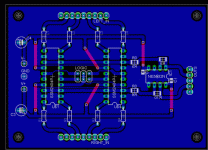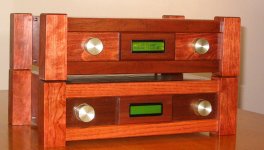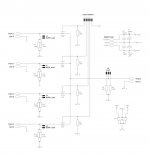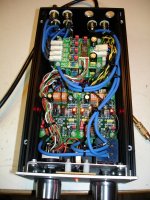I want to build a channel selector/mixer, followed by PGA2310. Most natural choice is virtual ground with some sort of switches. Now I have a couple of SSM2404 laying around. These switches are supposed to be absolutely transparent in current switching (as any other solid state switch, see SSM2404 datasheet for demonstration) and allow much more compact layout than say relays (example pcb attached).
A handful of relays is also an option but good ones are not cheap, take a lot of space, draw more current etc but supposedly give better performance.
Now, given that SSM2404 has already vanishingly low THD levels, would it make any sense to use relays instead (audiophile superstition exluded)
Datasheet:
http://www.analog.com/en/prod/0,2877,SSM2404,00.html
A handful of relays is also an option but good ones are not cheap, take a lot of space, draw more current etc but supposedly give better performance.
Now, given that SSM2404 has already vanishingly low THD levels, would it make any sense to use relays instead (audiophile superstition exluded)
Datasheet:
http://www.analog.com/en/prod/0,2877,SSM2404,00.html
Attachments
wxn said:Now, given that SSM2404 has already vanishingly low THD levels, would it make any sense to use relays instead (audiophile superstition exluded)
Datasheet:
http://www.analog.com/en/prod/0,2877,SSM2404,00.html
Wow. What a cool chip. I looked at using CMOS switches when I designed my preamp board, but all the ones I saw were junk. This one looks really good. From the look of it would be a wonderful alternative to relays. Certainly I'd have used it had I known about it.
On a related topic, have you tried discrete JFETs? I knocked together a sim using a PMBFJ176 and a PMBFJ112 back-to-back, and was very happy with the results. I found using N and P channel devices cancelled out much of the charge injection when switching, and reduced the distortion significantly.
I simulated a differential seven stage attenuator using no less than 21of these, and managed 0.0002% THD at 1KHz.
I can send the sim files if you like. It'd be a complex beast, but no doubt heaps of fun to build.
Cheers,
Suzy
Member
Joined 2004
The SSM2404 (quad) and SSM2402 (dual) are great for "click-less" switching. I find them great to replace other logic devices like the 4513 often used on DAC's. They can provide a major improvement.
Since they are logic based, they are easy to integrate into existing logic circuits. However, if you are designing a circuit from scratch, then you have to consider that the SSM2404/2 needs a logic circuit in order to function.
Some people like this, others do not. So, in my opinion they are slighty more complicated than a simple SPST relay. You use TTL/CMOS for control rather than current.
Also, if you need a SPDT switch, you have to use a DPDT format which can eat up the SPST switches per IC very quickly. This if fine for designing new circuits but knid of a pain if you modifying an existing one.
As anything there are pros and cons. BUT in the DIY world where you may be trying to make the best "whatever" you can,the SSM2404/2 is, in my opinion, often times better than a relay due to expense, size, and most of all sound.
K
Since they are logic based, they are easy to integrate into existing logic circuits. However, if you are designing a circuit from scratch, then you have to consider that the SSM2404/2 needs a logic circuit in order to function.
Some people like this, others do not. So, in my opinion they are slighty more complicated than a simple SPST relay. You use TTL/CMOS for control rather than current.
Also, if you need a SPDT switch, you have to use a DPDT format which can eat up the SPST switches per IC very quickly. This if fine for designing new circuits but knid of a pain if you modifying an existing one.
As anything there are pros and cons. BUT in the DIY world where you may be trying to make the best "whatever" you can,the SSM2404/2 is, in my opinion, often times better than a relay due to expense, size, and most of all sound.
K
Re: SSM2404
Well I'm not keen on soldering dozens of FETs. But it would be very interesting to see those sims. My email
But it would be very interesting to see those sims. My email
no-spam at kipsus dot info
Btw, any CMOS switch will be virtually distortion free if used in virtual ground mode because Ron is then very stable and so THD is very low. I'm concerned about crosstalk though. SSM2404 datasheet mentions VG switching and extremely low THD but not a word about crosstalk. No good if it's then -50db (because of the tradeoff between THD and isolation, depending on the load)
Good to know that I'm not the only one using SS switches
Is there a schematic published anywhere? If not, could you share the SSM2404 section?
I will be using a microcontroller anyway so that is no problem at all.
Yeah, that's the spirit of DIY. But AFAIK good relays, being totally passive high quality connections, do not alter the signal in any way. Or am I wrong?
And btw, for those who don't know - SSM2402 is the same as SSM2404 but a dual instead of quad and has MUCH better specs. I even think it can be safely used in voltage switching too.
suzyj said:
I simulated a differential seven stage attenuator using no less than 21of these, and managed 0.0002% THD at 1KHz.
I can send the sim files if you like. It'd be a complex beast, but no doubt heaps of fun to build.
Cheers,
Suzy
Well I'm not keen on soldering dozens of FETs.
no-spam at kipsus dot info
Btw, any CMOS switch will be virtually distortion free if used in virtual ground mode because Ron is then very stable and so THD is very low. I'm concerned about crosstalk though. SSM2404 datasheet mentions VG switching and extremely low THD but not a word about crosstalk. No good if it's then -50db (because of the tradeoff between THD and isolation, depending on the load)
RCBandwidth said:WXN: I have used them in a few of my preamps,I have no complaints they perform quite well, others in this forum have used them also.
Bob C.
Good to know that I'm not the only one using SS switches
Is there a schematic published anywhere? If not, could you share the SSM2404 section?
quamen said:
Since they are logic based, they are easy to integrate into existing logic circuits. However, if you are designing a circuit from scratch, then you have to consider that the SSM2404/2 needs a logic circuit in order to function.
I will be using a microcontroller anyway so that is no problem at all.
As anything there are pros and cons. BUT in the DIY world where you may be trying to make the best "whatever" you can,the SSM2404/2 is, in my opinion, often times better than a relay due to expense, size, and most of all sound.
K
Yeah, that's the spirit of DIY. But AFAIK good relays, being totally passive high quality connections, do not alter the signal in any way. Or am I wrong?
And btw, for those who don't know - SSM2402 is the same as SSM2404 but a dual instead of quad and has MUCH better specs. I even think it can be safely used in voltage switching too.
You are right about relays. If they are from a quality source they "should" not degrade/alter the signal. When I said sound, I should have clarified it, I meant the sound of switching on and off. Relays are used often in recording equipment (my background). They can cause clicks and pops which are annoying. Whereas the SSM chips in question are "noise-less" in this regard.
K
K
Re: Re: SSM2404
I've bunged them up on the web.
http://www.littlefishbicycles.com/misc/attenuator.asc
http://www.littlefishbicycles.com/misc/jfet_switch.asc
http://www.littlefishbicycles.com/misc/jfet_switch.asy
Cheers,
Suzy
wxn said:Well I'm not keen on soldering dozens of FETs.But it would be very interesting to see those sims.
I've bunged them up on the web.
An externally hosted image should be here but it was not working when we last tested it.
An externally hosted image should be here but it was not working when we last tested it.
http://www.littlefishbicycles.com/misc/attenuator.asc
http://www.littlefishbicycles.com/misc/jfet_switch.asc
http://www.littlefishbicycles.com/misc/jfet_switch.asy
Cheers,
Suzy
ACD said:The SSM2404 are just great
I use it in all my preamp projects....
Hi Jan,
may I ask you for further elaboration (shematics, ...)?
Best regards,
Interesting project. I'm still in need of an attenuator for my system (when it's completed), and it'll need to be a six channel one. 3 of these boards looks like a possible option. How many attenuation levels does this give? I guess a PIC is ideal to control these?
With regards to crosstalk, the top of the datasheet says "low crosstalk: -94db typ", but this may be measured differently to what your doing. As you can tell this isn't something I know much about but it caught my attention as its something I will be in need of!
With regards to crosstalk, the top of the datasheet says "low crosstalk: -94db typ", but this may be measured differently to what your doing. As you can tell this isn't something I know much about but it caught my attention as its something I will be in need of!
Hi Jan,
may I ask you for further elaboration (shematics, ...)?
This simple schem is my latest. I made it a year ago for testing high Current 50 Ohm Impedanced interconnections between Line Level Sources (Therefore the J1-14 Jumpers and R9-R14 load resistors).
Attachments
And here is the test rig that have been running for the last year.
Two SSM2404 mono Input circuits (at the far back), each with it's own regulated power supply. In the front you see two mono Output Buffers (also each with their own regulated supply) to connect to the Power Amp.
What a difference compared to normal interconnections
Two SSM2404 mono Input circuits (at the far back), each with it's own regulated power supply. In the front you see two mono Output Buffers (also each with their own regulated supply) to connect to the Power Amp.
What a difference compared to normal interconnections
Attachments
Hi Jan,
thank you very much for your exhaustive answer!
May I add the exclamation mark to your above statement?
Seriously:
on your attached photo the well done SSM2404 PCB is seen...
Any bussiness possible?
Best regards,
thank you very much for your exhaustive answer!
ACD said:What a difference compared to normal interconnections
May I add the exclamation mark to your above statement?
Seriously:
on your attached photo the well done SSM2404 PCB is seen...
Any bussiness possible?
Best regards,
Seriously:
on your attached photo the well done SSM2404 PCB is seen...
Any bussiness possible?
Yes around mid May
ACD said:
Yes around mid May
Hi Jan,
April I to suggest you to speed up a little bit your delivery conditions?
Further questions...
At what charge?
SSM2404 included?
Best regards,
- Status
- This old topic is closed. If you want to reopen this topic, contact a moderator using the "Report Post" button.
- Home
- Amplifiers
- Solid State
- SSM2404 - worth bothering?



